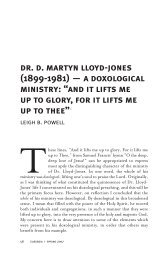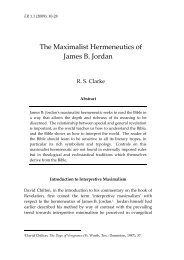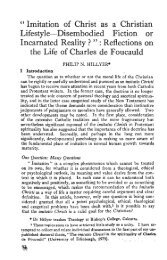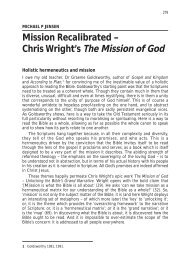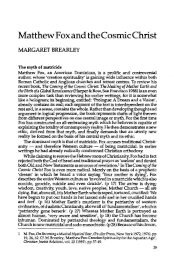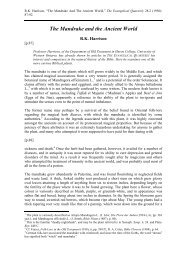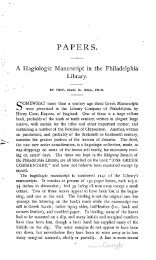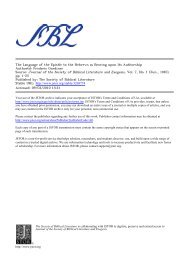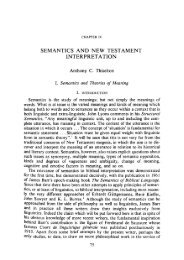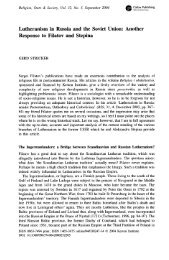Ancient Orient and Old Testament - BiblicalStudies.org.uk
Ancient Orient and Old Testament - BiblicalStudies.org.uk
Ancient Orient and Old Testament - BiblicalStudies.org.uk
Create successful ePaper yourself
Turn your PDF publications into a flip-book with our unique Google optimized e-Paper software.
K.A. Kitchen, <strong>Ancient</strong> <strong>Orient</strong> <strong>and</strong> <strong>Old</strong> <strong>Testament</strong>. London: Inter-Varsity Press, 1966. Hbk. pp.191.<br />
of Amaziah, father of Uzziah; i.e., we must underst<strong>and</strong> ‘Joram begat (the line culminating in) Uzziah’<br />
as far as chronology is concerned. A much earlier parallel is provided by the eight, nine or ten rulers 12<br />
who reigned from the beginning of kingship until the Flood according to an old Mesopotamian<br />
tradition prefixed to the Sumerian King List about 1800 BC. 13 And after the Flood at least, the<br />
Sumerian King List itself is known to have sometimes omitted both individual kings <strong>and</strong> whole<br />
dynasties. 14<br />
Secondly, the terminology of the genealogies does not prove that they are continuous throughout.<br />
Sometimes the adjoining narrative would suggest that certain parts of the genealogies are continuous<br />
(so: Adam to Enosh; Lamech to Shem; Nahor(?) to Terah; Terah to Abraham). Everywhere else, a<br />
continuous sequence cannot be automatically assumed without proof. Such a mixture of continuous<br />
<strong>and</strong> selective genealogy is in no way abnormal. Besides the obvious example of Matthew 1 :117, the<br />
Abydos King List in Egypt silently omits three entire groups of kings (Ninth to early Eleventh,<br />
Thirteenth to Seventeenth Dynasties <strong>and</strong> the Amarna pharaohs) at three separate points in an<br />
otherwise continuous series; other sources enable us to know this. Or compare Jacobsen, 15 who<br />
derived from other sources the procedure of arrangement probably followed by the ancient author of<br />
the Sumerian King List <strong>and</strong> not obvious from its structure, as well as from certain King List<br />
statements.<br />
The phrase ‘A begat B’ does not always imply direct parenthood. This is shown by its use in Matthew<br />
I in cases where<br />
[p.39]<br />
links are known (from the <strong>Old</strong> <strong>Testament</strong>) to have been omitted (cf. pp. 37-38, above). Likewise, in<br />
Genesis 46:18, the children that ‘Zilpah bare to Jacob’ are known to include great-gr<strong>and</strong>sons. Terms<br />
like ‘son’ <strong>and</strong> ‘father’ can mean not only ‘(gr<strong>and</strong>)son’ <strong>and</strong> ‘(gr<strong>and</strong>)father’ but also ‘descendant’ <strong>and</strong><br />
$ancestor’ respectively. The noted charioteer Jehu ‘son’ of Nimshi (1 Ki. 19:15; 2 Ki. 9:20) was<br />
strictly son of a Jehoshaphat, <strong>and</strong> so gr<strong>and</strong>son of Nimshi (2 Ki. 9:2). Likewise in Amarna Letter No.<br />
9, Burnaburiash III, King of Babylon, calls Kurigalzu I his ‘father’; but ‘(gr<strong>and</strong>) father’ is to be understood,<br />
because he is more precisely entitled ‘eldest son’ of an intervening king. 16 Ramesses II is<br />
called ‘father’ of Sethos II in Pap. Gurob 2:7, although he could not be closer than gr<strong>and</strong>father; 17 cf.<br />
the address to Belshazzar in Daniel 5:11 where ‘father’=‘predecessor’ in both cases. An extreme<br />
12 Cf. W. G. Lambert, JSS 5 (1960), p. 115.<br />
13 On date <strong>and</strong> composition of this King List, see T. Jacobsen, The Sumerian King List, 1939, pp. 55-68, 128<br />
ff.; F. R. Kraus, ZA 50 (1952), pp. 49 ff.; Rowton, JNES 19 (1960), pp. 156-162 <strong>and</strong> in CAH 2 , I: 6 (Chronology),<br />
1962, pp. 30-31; Gadd, CAH 2 , I:13 (Cities of Babylonia), 1962, pp. 15-17. Translations of the King List,<br />
Jacobsen, op. cit., pp. 71-127; A. L. Oppenheim, ANET, pp. 265-266 (partial), <strong>and</strong> Kramer, The Sumerians,<br />
1963, pp. 328 - 331.<br />
14 Gadd, op. cit., p. 16; cf. Jacobsen, op. cit., pp. 180-183 (dynasties of Lagash, Umma <strong>and</strong> elsewhere; reasons<br />
for this).<br />
15 The Sumerian King List, 1939, p. 160.<br />
16 Knudtzon, Die El Amarna Tafeln, I, No. 9. Cf. K. Jaritz, MIO 6 (1958), pp. 212 n. 89, 241 No. 81; Kitchen,<br />
Suppiluliuma <strong>and</strong> the Amarna Pharaohs, 1962, p. 10 n. 5.<br />
17 Gardiner, JNES 12 (1953), p. 146.




